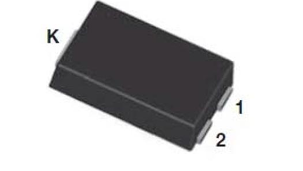Work Function and Barrier Formation
Date:2025-05-21 Categories:Product knowledge Hits:459 From:Guangdong Youfeng Microelectronics Co., Ltd
3. Work Function and Barrier Formation
The work function (Φ) of a material represents the minimum energy required to remove an electron from its surface. Metals generally have a higher work function than n-type semiconductors.
Schottky diode .
When a metal with a higher work function is brought into contact with an n-type semiconductor, electrons from the semiconductor are attracted to the metal. This causes a depletion of electrons near the semiconductor surface, creating a positively charged region known as the depletion region.
Simultaneously, a negative charge accumulates on the metal side of the interface. As a result, an electrostatic potential barrier, the Schottky barrier, is established at the metal-semiconductor interface. The height of this barrier,
ΦB, is determined by the difference between the metal work function (ΦM) and the electron affinity (χ) of the semiconductor, expressed as ΦB=ΦM−χ. This barrier controls the flow of electrons across the junction.
4. Forward Biasing and Current Conduction
When a
Schottky diode is forward-biased, an external voltage is applied such that the anode (connected to the metal) is made positive with respect to the cathode (connected to the n-type semiconductor). This applied voltage opposes the built-in Schottky barrier. As the forward voltage increases and reaches a certain threshold (usually around 0.3 - 0.5 volts for silicon-based Schottky diodes, much lower than the 0.7 volts for silicon p-n junction diodes), the barrier height is reduced significantly.
Once the barrier is sufficiently lowered, electrons from the n-type semiconductor can easily overcome the barrier and flow into the metal. This flow of electrons constitutes the forward current of the Schottky diode. Since the current in a
Schottky diode is mainly due to the majority carriers (electrons in the n-type semiconductor), there is no significant charge storage effect as in p-n junction diodes. This absence of minority carrier storage enables
Schottky diode to switch on and off rapidly, making them ideal for high-frequency applications.

Previous:
Classification, Structure, and Principle of MOSFET
Next:
Reverse Biasing
